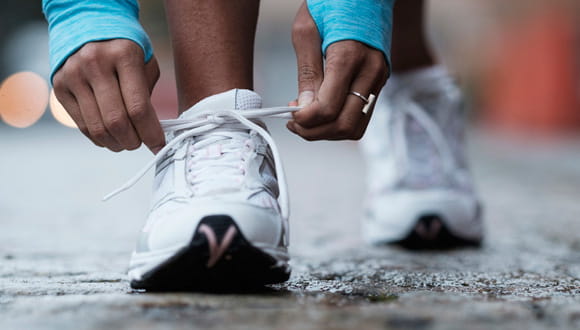Most of us have a pair of athletic shoes hanging around that serve as our all-purpose exercise shoes. You wear them on a run, the elliptical, a walk — anytime you're active.
But, while a shoe you can wear almost anywhere is certainly convenient, it may not always be practical.
When it comes to your walking routine, it's important to be sure that the shoes you're wearing promote proper foot biomechanics — especially if you walk often and/or for long distances.
Why invest in a pair of walking shoes?
Believe it or not, your foot biomechanics while walking are fairly different from when you're running.
For instance, your foot typically strikes the ground at your heel while you're walking. While running, on the other hand, your foot strikes the ground somewhere around your midfoot. This is one reason why running shoes have become their own category of shoes.
Some of the differences between running shoes and walking shoes aren't of huge consequence on a walk, such as how running shoes tend to be very lightweight and provide more motion control than needed while walking.
However, other attributes of running shoes, such as the tendency to have a firmer sole and built-up heel, may actually force you to change the way your foot would otherwise naturally strike the ground while walking — which may ultimately contribute to foot and leg pain.
How should a walking shoe fit?
If you're now convinced that you need dedicated walking shoes, here are four tips for picking out a walking shoe that's right for you:
1. Walking shoes should be comfortable right away
It may sound obvious, but we'll say it anyway: If a shoe doesn't feel immediately comfortable on your foot, it's not a good walking shoe for you.
We're likely all guilty of telling ourselves, "These shoes just need to be broken in a little." But avoid doing so with your walking shoes.
If a quick lap around the shoe store or your home is enough to lead to foot discomfort, taking a walk in the same shoes may easily result in painful blisters and calluses.
2. Your feet should have room, but not too much room
Every shoe manufacturer designs shoes slightly different. When choosing a walking shoe, make sure it feels like a good fit — regardless of the brand or size.
First, the toe box of the shoe should be spacious enough that your toes have plenty of wiggle room, but not too much. As a rule of thumb, make sure there's about half an inch of space between your big toe and the front of the shoe.
The side-to-side space in the shoe matters, too. If you have a wider foot, you may need to look for a walking shoe that offers "wide" size options.
Lastly, if one of your feet is slightly larger than the other, you may need to go a half size up to ensure the shoes adequately conform to both feet.
Shoe shopping pro tip: Bring the socks you plan to wear on your walks with you to the shoe store, as sock thickness can affect the fit of a shoe.
3. Your walking shoes should match your arch type
Your foot arch provides support by redirecting the pressure placed on your foot as you take a step. Your arch also help your foot firmly interact with the various surfaces you encounter while walking.
But, not all foot arches are the same — and this can affect the type of walking shoe that will likely work best for you.
The three overarching (heh) foot arch types include:
- Normal arch – a generally biomechanically correct foot (look for a shoe with a firm but flexible midsole and heel stability)
- Flat arch – associated with excessive foot motion (look for a shoe that provides plenty of stability and motion control)
- High arch – poor at shock absorption (look for a shoe with plenty of cushioning and stability)
One of the best ways to determine your foot arch type is to seek guidance from a sales associate at a specialty shoe store. This may be especially important if you're looking for a walking shoe that's best for pronation (the natural inward roll of your foot) issues — including the underpronation (when your heels roll outward) or overpronation (when your feet roll inward excessively) that can occur with high or flat arches, respectively.
But, there's also a quick DIY method to determine your foot type. Simply wet your feet and stand on dry cement or cardboard. From your footprint, you can get a general sense of your arch type.
4. Cushion and traction are important with walking shoes
Last, but not least: You're walking, so the shoes you choose should reduce the stress placed on your feet as each hits the ground, as well as provide stability and grip.
The insole of a good walking shoe provides cushion with each step, but it should also feel like it's adequately supporting the arch of your foot.
The midsole is another layer of cushion in a shoe — usually made of foam, air or gel — that also helps absorb shock as your foot hits the ground.
The outer sole of a good walking shoe provides adequate traction, naturally helping your foot grip the surface below you as you walk.
Finally, the heel of a good walking shoe offers cushion and support to both your Achilles tendon and ankle.
The cushion, stability and traction of a shoe degrade as you walk in them. After logging between 300 to 400 miles in your walking shoes, it's time for new ones.


